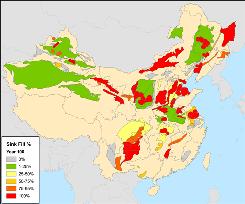
Report: China could cheaply control
coal-plant emissions
Oct 14, 2009 - Dan Vergano - USA
Today
 Frantzesco Kangaris, AFP/Getty
Images
Frantzesco Kangaris, AFP/Getty
Images |
| Norway Minister of Petroleum
and Energy Terje Riis-Johansen speaks at the Carbon
Sequestration Leadership Forum in London, Oct.
13. International energy and environment ministers
converged on London Tuesday to move collaboration
on carbon capture and storage forward ahead of
the U.N. Climate Change talks in Copenhagen. |
|
HOW SEQUESTERING WORKS
China has 90 geologic formations that could "sequester"
carbon dioxide from power plants and factories
before it can enter the atmosphere.
1) Burning coal or other fossil
fuels produces a concentrated stream of flue
gases through various combustion methods. For
geologic storage, the gas is captured and sent
by pipeline to a well over a deep saltwater
reservoir.
2) The gas is compressed and
injected into the reservoir, typically capped
by impermeable rock. Volcanic basalt layers
might also hold the gas.
3) The gas remains trapped
in the reservoir. About 30% of the gas will
dissolve into the water within a few decades.
Below 2,600 feet, the gas becomes liquid and
can be trapped in porous rock.
4) Monitoring of the reservoir
continues to ensure there are no leaks, which
could pose a health hazard if concentrated gas
escapes. But a 2005 Intergovernmental Panel
on Climate Change report rated it "very likely"
such reservoirs would trap 99% of the gas for
a century.
5) Over centuries, much of
the gas would dissolve into the saline water
deposit, although monitoring probably would
continue. Source: "Carbon Dioxide Capture and
Storage" report, Intergovernmental Panel on
Climate Change
|
 Pacific Northwest National Laboratory,
Chinese Academy of Sciences, Joint Global Change
Research Institute, Department of Energy
Pacific Northwest National Laboratory,
Chinese Academy of Sciences, Joint Global Change
Research Institute, Department of Energy |
| A map of China shows geologic
structures able to store carbon dioxide captured
from coal plants and other industries, color-coded
to show how full they would be (by percentage)
in 2100. |
Getting China's coal-plant emissions
out of the atmosphere so they don't worsen global
warming may be cheaper, easier and longer-lasting
than expected, a federal energy lab report finds.
The Pacific Northwest National Laboratory
report, set for release today in London, says there
are vast underground reserves in China that can be
used for "carbon sequestration," a carbon dioxide-trapping
technology considered vital to cutting greenhouse
gas emissions.
"Conventional thinking had been that
China did not have a lot of storage for carbon. But
it turns out China does," says the lab's Robert Dahowski,
the report's lead author. "Enough for many decades,
perhaps hundreds of years."
Carbon sequestration, which today is
used only in a few oil fields and experimental projects,
works by capturing carbon dioxide from smokestacks,
compressing it and pumping it underground into deep
saltwater reservoirs capped by layers of impermeable
stone.
In 2007, the Intergovernmental Panel
on Climate Change found that global atmospheric temperature
rose about an average of 1.3 degrees Fahrenheit over
the past century. About about half of this "global
warming" is driven by fossil-fuel-related emissions
of carbon dioxide.
The report finds that the cost of transporting,
injecting and monitoring carbon dioxide from China's
1,623 largest sources — coal, cement, ammonia plants
and factories — would average $5 to $7 a ton, about
half of estimated costs in the USA.
Further, China's deep geology features
rock layers that are perfect for pumping carbon dioxide
underground. The report maps at least 2,300 billion
metric tons of potential underground storage for carbon
in China, Dahowski says. China's major plants emit
about 3.8 billion metric tons a year.
"I would call it good news for the
climate," says geologist Julio Friedmann of the Lawrence
Livermore (Calif.) National Lab, who was not part
of the study. Friedmann says China's geology, coal
use and low construction costs make pumping carbon
underground "low-hanging fruit" to cut greenhouse
gas emissions.
On Monday, Energy Department chief
Stephen Chu called for "widespread, affordable" carbon
storage in 10 years. Chu noted that coal, on which
China and the USA depend for electricity, supplies
25% of the world's energy and accounts for 40% of
carbon emissions.
"The next step for carbon sequestration
is really just doing it on a large scale," says Stanford's
Franklin Orr, who wrote a review of the technology
in the journal Science last month. "The technology
is there already."

|



 Frantzesco Kangaris, AFP/Getty
Images
Frantzesco Kangaris, AFP/Getty
Images